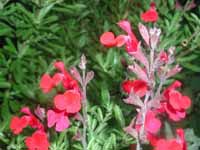Resource Library
Plant of the Week: Autumn Sage
The University of Arkansas System Division of Agriculture does not promote, support or recommend plants featured in "Plant of the Week." Please consult your local Extension office for plants suitable for your region.
Plant of the Week
Autumn Sage
Latin: Salvia greggii

A couple years ago I went through the salvia phase of my life. I acquired all of the new and interesting salvias then available and planted them out to see which species would survive here in north Arkansas as a perennial. One of my favorites of this group was Salvia greggii, the Autumn Sage.
The Autumn Sage is a subshrub that can grow as much as 30 inches tall and wide with a woody base and slender new herbaceous shoots. In milder areas it is evergreen but in north Arkansas it loses its leaves in the winter and often dies back to the thicker wood at the base of the plant. The leaves are green, oblong in outline and entire with a slight sage smell when crushed.
The showy, usually red flowers are produced in terminal racemes held above the foliage during the spring and fall with only scattered blooms during the heat of summer. The flowers are two-lipped with the lower lip considerably enlarged and about the size of a dime. The calyx, while not colored like other salvias, forms an attractive v-shaped collar for the base of the floral tube.
Breeders have been busy working on the Gregg Salvia and now have a wide array of colors including various shades of red, pink, white and yellow. As often seems the case when plant breeders get involved the color variants seem less thrifty. Only the red and pink forms have been consistently cold hardy in my plantings.
Salvia greggii is native to Texas, Mexico and parts of Arizona. It was first collected by Josiah Gregg (1806-1850) in 1846 when he joined a regiment of Arkansas volunteers on their way to Mexico to fight in the Mexican - American War. One of the soldiers on this march described Gregg as sitting stiffly upright on his mule with a look of disdainful interest on his face while holding a red silk parasol to shade himself from the midday sun.
Gregg was a loner by nature who wandered about the western frontier and taught himself a number of professions, including surveying, cartography, teaching, lawyering and even doctoring. He stuck to none of these professions very long and is remembered today for his venture into natural history. His plant collections went to Dr. George Engelmann in St. Louis.
In 1849 Gregg caught gold fever and headed to northwestern California where he and a small band spend a cold and hungry winter seeking their fortune. Gregg's interest in natural history put him at odds with the rest of his party. At one point, as the party ran low on food and ammunition, Gregg stopped to measure the diameter of some redwoods.
The men were ready to proceed and finally launched their canoes with the threat to leave Gregg behind in the wilderness. He waded into the stream and unleashed a string of curses befitting the best sailor, thus spawning the incident which gave Mad River the name it bears today. A few days later a traveling companion stated that Gregg fell from his saddle without a word, dying of starvation.
Autumn sage is best in full sun in a well drained, somewhat sandy site. Like most dryland plants of the American southwest it resents heavy, wet soils in the winter. It may freeze back during the winter but usually regrows from the larger branches at the base of the plant. It has great heat and drought tolerance but only flowers well during more congenial weather. To increase the chance of it getting established in the northern part of its hardiness range, it should be planted in the garden only in early spring. It seems unbothered by insects or disease.
By: Gerald Klingaman, retired
Extension Horticulturist - Ornamentals
Extension News - June 21, 2002
The University of Arkansas System Division of Agriculture does not maintain lists of retail outlets where these plants can be purchased. Please check your local nursery or other retail outlets to ask about the availability of these plants for your growing area.